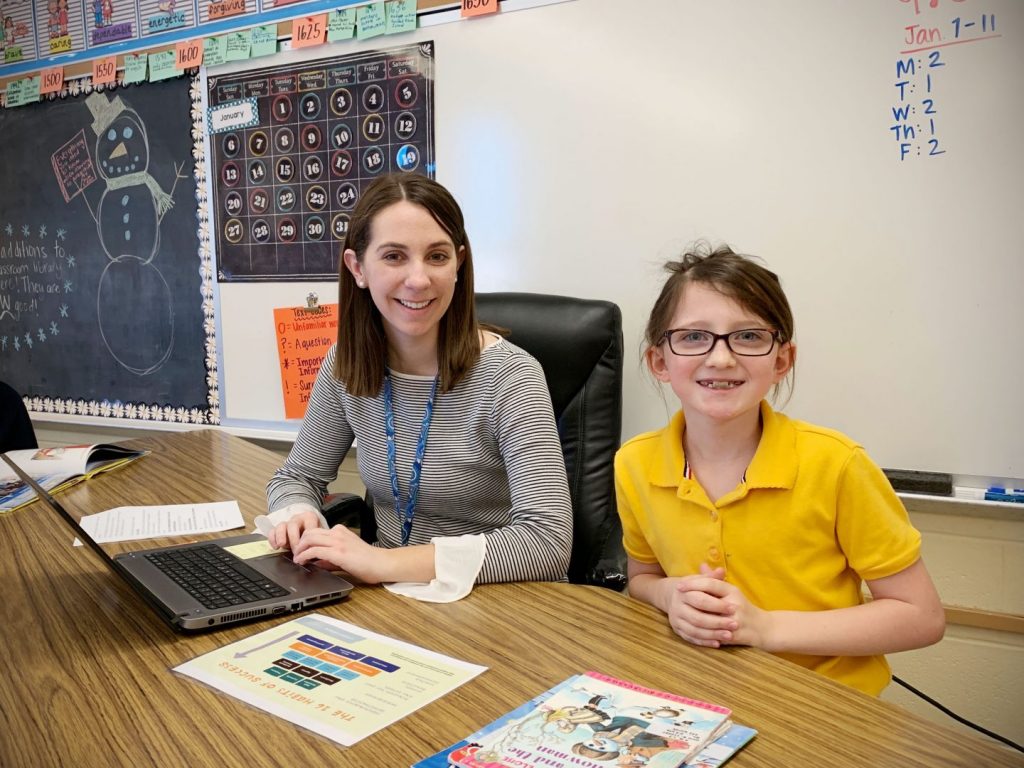
Mentoring in Personalized Learning
In Personalized Learning, mentoring is defined as the weekly, one-to-one connection between a student and an assigned adult in the school. The pair uses a rigorous and customized set of tools to set goals, determine strategies, reflect on successes and setbacks. The content of these mentoring conversations is generalized so that students can see how habits are supporting and hindering academic, extracurricular, and personal success and any places where support is needed.
Mentoring typically starts with ensuring there is a connection between the mentor and mentee, as this connection becomes the foundation of trust upon which honest conversations can happen about progress and struggles. This connection allows mentors and mentees to build a weekly cadence for conversations about progress in which the mentee prepares by reflecting on what worked and what didn’t from the previous week, and the mentor provides feedback and suggestions.
MENTORING HAS THE FOLLOWING KEY CHARACTERISTICS:
Conversations are rigorous and personalized.
- Mentors build rigorous check-in agendas for their mentees which they are able to share with them in the Summit Learning Platform. Mentees receive these agendas and prepare for their check-ins. Over time, the onus of planning shifts from the mentor to the mentee as the mentee develops the practices and routines to reflect on progress and consider alternative strategies in advance of the check-in and uses the check-in as a consultation. Mentors are equipped with sample agendas and many strategies for ensuring that the check-in stays focused and also that it is responsive to the unique learning needs of the individual mentee.
Mentors several roles.
- As a mentor, our personalized learning educators become the point-person for the student and the family. Students know they can go to their mentor as a central point of contact at the school and, over time, families build a connection with the mentors that allows them to always know that they can reach out to find out about their child’s progress or school experience. As such, mentors are typically a liaison between the school community and the student and family.
- Mentors are also accountability partners for students. With a deep understanding of the Summit Learning Outcomes and the school expectations, the mentor stays up-to-date with a student’s progress across all classes and supports the student to build systems that allow for on-track grades. The mentor is also a coach for Habits as check-ins often highlight habit goal areas. Mentors might help students who get stressed by upcoming deadlines consider ways of positively directing that stress. They may support students who are struggling to find a sense of belonging in the school community to consider strategies to engage.
- Finally, the mentor is the point person for the student when considering what is next. In high schools, this looks like being a formal or informal advisor as the student considers post-secondary options.
There is a balance between academic accountability and habit development.
- Personalized Learning mentors often feel a tension between being the point of accountability for academic progress and the coach of Habits. When acting as the Habits coach, the mentor wants to support the student in working through the self-directed cycle of setting goals, making and executing on a plan, and assessing whether the plan was successful. When acting as the academic accountability point of contact, the mentor wants to tell the student what s/he needs to do to complete an upcoming checkpoint or pass an overdue content assessment. Wearing these two different hats takes balance. The most effective Summit Learning mentors learn that, until students have strong habits, their role is to provide scaffolds that can be easily removed.
ROLES IN MENTORING
Students
- Students prepare for their weekly check-ins by responding to the prompts their mentors share and by reflecting on how they met or struggled to meet their goals. Students come to the check-in ready to connect with their mentor so that they are comfortable sharing what is supporting their success and what is causing any gaps. Students are open to and ready to accept feedback and challenges that are presented to them by their mentor and, over time, by themselves as they internalize the structures of mentoring and build those into their own systems.
Teacher
- Teachers prepare for weekly check-ins by scoping out an appropriate agenda or giving feedback on an agenda designed by a mentee. They come to the check-in ready to connect with their mentees so they can be a trusted figure with whom a mentee is ready to reflect and share. They are also a point of accountability and representative of the outside world with its deadlines and expectations. Teachers provide scaffolds for habits until mentees are ready to build their own systems and structures.
Platform
- The Platform hosts agendas that mentors and mentees can share. This allows preparation that facilitates rigorous, consistent check-ins. The Platform also allows students and their teachers to review both academic progress from the week and the goals and learning strategies that students used to achieve them. The Platform also allows families to see what is being discussed during the mentor check-in and the underlying student results that motivated that conversation.
 Contributed by Lisa Krapfl, Wahlert Catholic High School Assistant Principal lkrapfl@holyfamilydbq.org.
Contributed by Lisa Krapfl, Wahlert Catholic High School Assistant Principal lkrapfl@holyfamilydbq.org.
Read more about mentoring and personalized learning at Holy Family, or contact us at admissions@holyfamilydbq.org to schedule a personal tour of our schools or student shadow experience today!
